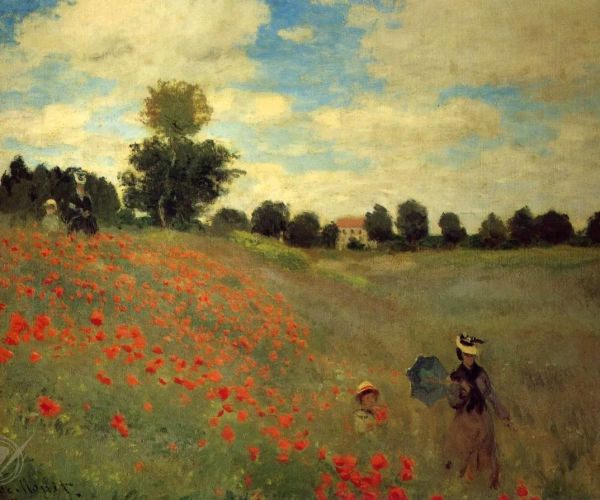Wild Poppies, Near Argenteuil
"Claude Monet's 'Wild Poppies, Near Argenteuil,' painted in 1873, is an exquisite representation of the French countryside's natural beauty and a superb example of the Impressionist movement's ethos. This work captures a fleeting moment in nature, characterized by vibrant colors, light play, and a sense of immediacy that Monet so masterfully conveyed in his landscapes.
The painting features a field near Argenteuil, where Monet lived from 1871 to 1878. It shows a mother and child walking through a sea of red poppies under a vast, expansive sky. The scene is infused with a sense of tranquility and simple joy, reflecting Monet's fascination with the interplay between light, color, and the natural environment.
One of the painting's most striking features is its vibrant color palette. Monet uses various shades of green and red to create a lively and dynamic depiction of the poppy field. The reds of the poppies, interspersed with the greens of the grass and the blues and whites of the sky, create a harmonious and vivid landscape that almost seems to pulse with life.
Monet's brushwork in 'Wild Poppies, Near Argenteuil' is loose and expressive, typical of the Impressionist style. He captures the essence of the scene with quick, spontaneous brushstrokes, conveying the movement of the breeze through the field and the shifting light of the open sky. This technique gives the painting a sense of immediacy and fluidity, as if the viewer is witnessing a brief, fleeting moment in time.
The inclusion of the figures, the mother and child, adds a human element to the landscape, creating a connection between the viewer and the scene. They are not just observers of nature but are part of it, immersed in the beauty of the moment. This integration of human figures into the landscape was a common theme in Monet's work, reflecting his belief in the unity between humans and nature.
In summary, 'Wild Poppies, Near Argenteuil' is not only a visually stunning piece but also a profound expression of Monet's love for the natural world and his innovative approach to capturing the ephemeral qualities of light and color. This painting stands as a testament to Monet's mastery of landscape painting and his significant contribution to the Impressionist movement."







No Comments Yet...